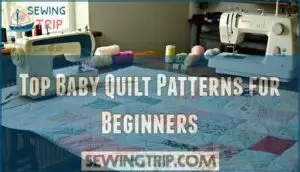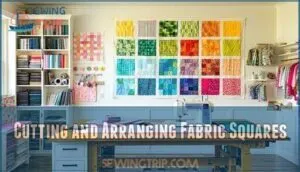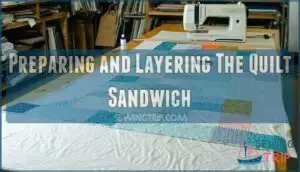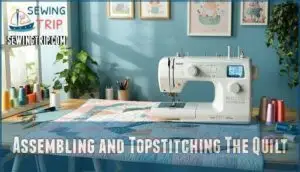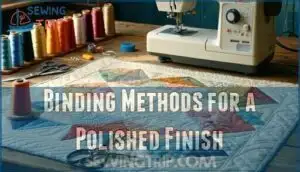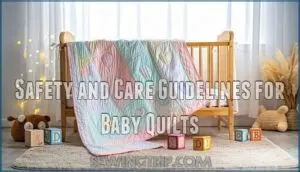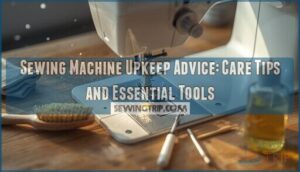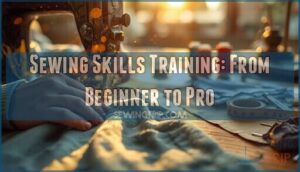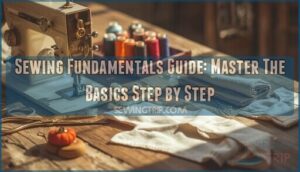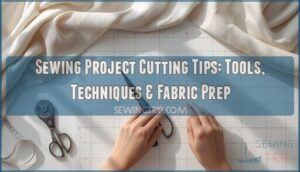This site is supported by our readers. We may earn a commission, at no cost to you, if you purchase through links.
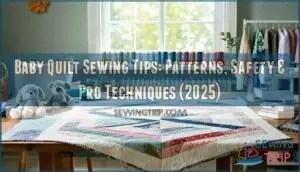
Whether you’re crafting your first patchwork design or refining your binding technique, mastering a few essential baby quilt sewing tips transforms your project from homemade to heirloom-worthy.
Table Of Contents
Key Takeaways
- Choosing 100% cotton fabrics with hypoallergenic batting and avoiding embellishments like buttons or beads creates a safe, durable quilt that protects babies from choking hazards and allergens while surviving countless washes.
- Starting with beginner-friendly patterns like simple patchwork, four-patch designs, or rail fence layouts—especially using precut fabric packs—helps new quilters build essential skills without overwhelming complexity.
- Proper quilt sandwich construction (backing, batting, and top layers) combined with consistent topstitching and folded binding with mitered corners transforms separate fabric pieces into a polished, long-lasting keepsake.
- Following pediatric safety standards like the Flammable Fabrics Act and using gentle washing practices with fragrance-free detergent ensures your finished quilt remains safe and beautiful through years of use.
Essential Materials for Baby Quilt Sewing
Getting started with baby quilt sewing means gathering the right materials before you cut your first square. You’ll need fabrics that are soft, safe, and sturdy enough to hold up through countless cuddles and washes.
Let’s look at what belongs in your shopping basket to set you up for success.
Choosing Quality Fabrics and Batting
The fabric and batting you choose form the heart of your baby quilt—they’ll determine how soft it feels against delicate skin, how well it holds up through countless washes, and whether it becomes a cherished keepsake or just another blanket.
You’ll want 100% cotton or cotton blendables for breathability and material durability, paired with quilt insulation like Warm and Natural batting that won’t bunch.
Quality thread choices matter too—they hold your quilt design together through years of love.
Precut Vs. Custom-Cut Fabric Squares
You’ve got two roads to take here—grab a bundle of precut charm squares that’ll have you stitching in minutes, or pull out your rotary cutter and slice your own fabric for complete creative control.
Precut charm squares offer fabric efficiency and consistent square sizes, perfect for quick patchwork quilts.
Custom-cutting with your rotary cutter gives you precision cutting and fabric selection freedom, though you’ll need sharper cutting tools and may face more fabric waste.
Selecting Safe and Hypoallergenic Materials
Once you’ve made your fabric choice, it’s time to think about what’s actually touching that precious baby skin—because the softest cotton in the world won’t matter if it triggers a rash or poses a hidden danger.
Look for these essentials:
- Hypoallergenic fabrics like chemical-free cotton or breathable Cuddle fabric that won’t irritate sensitive skin
- Sustainable textiles with eco-friendly dyes free from harsh processing agents
- Quality materials such as Warm and Natural batting and PolyLite thread for safe, durable construction
Your fabric selection sets the foundation for a quilt that’s both gentle and long-lasting.
Tools and Notions for Efficient Quilting
Having the right tools at your fingertips can turn a tedious afternoon project into a smooth, satisfying few hours at your sewing machine. You’ll want sharp Rotary Cutters for precise cuts, quality Quilting Needles matched to your Sewing Machines, and reliable Thread Choices that won’t snap mid-seam.
Clover Wonder Clips hold layers better than pins, while Quilting Hoops keep tension even—small upgrades that make a real difference in your Quilting Techniques.
Top Baby Quilt Patterns for Beginners
Starting with a baby quilt opens up a world of beginner-friendly patterns that won’t overwhelm you. From classic patchwork squares to quick strip-pieced designs, you’ll find options that teach essential skills without demanding weeks of work.
Here’s a look at four tried-and-true patterns that’ll have you quilting with confidence from your very first project.
Simple Patchwork and Four-Patch Designs
If you’re brand new to quilting, simple patchwork and four-patch designs are your best friends—they’re straightforward, forgiving, and surprisingly satisfying to piece together.
Start with patchwork basics: grab precut charm squares in coordinating fabric choices, arrange them into cheerful quilt blocks, and use basic sewing techniques to join them.
Four-patch patterns are especially beginner-friendly—you’ll master essential skills while creating adorable baby quilt patterns that look far more impressive than the effort required.
Fast Rail Fence and Brick Patterns
Rail Fence Tips keep your momentum going—strip-piecing three coordinating fabric strips together, cutting into segments, then rotating every other block creates instant visual rhythm perfect for Baby Quilt Sizes.
Fast Assembly Methods shine here:
- Use Precut Charm Squares for no-fuss cutting
- Try Brick Pattern Variations with rectangles for modern Patchwork Quilts
- Add simple Quilt Border Designs to frame your Baby Quilt Patterns
Rail Fence designs finish quickly without sacrificing charm. For a traditional quilt design, consider exploring quilt pattern options to improve your project.
Modern Star and Lone Star Variations
Star quilts don’t just catch light—they capture hearts, and you’ll find that giant star patterns or classic Lone Star variations work up faster than you’d expect when you’re using simple piecing tricks.
| Star Variation Techniques | What Makes Them Work |
|---|---|
| Easy Star Quilt blocks | Four-patch foundations speed assembly |
| Lone Star Blocks with Sawtooth Border | Frames your star beautifully |
| Modern Fabric Choices | High-contrast prints add drama |
| Giant star layouts | Fewer seams mean quicker finishes |
| Strip-pieced diamonds | Chain-piecing saves time on Patchwork Quilts |
Star Pattern Tips let you play with quilting techniques while Quilt Border Ideas frame your work perfectly—these quilting patterns deliver maximum impact with minimum fuss.
Using Precut Fabric Packs for Easy Assembly
Precut fabric packs are like having someone else do your prep work—you can skip the measuring and cutting and jump straight into the fun part of piecing your quilt together. Here’s why they’re perfect for your first baby quilt:
- Charm Packs give you 5" squares that coordinate beautifully—no second-guessing your fabric selection.
- Jelly Roll Precuts offer 2½" strips ready for rail fence or brick quilt layouts.
- Pack sizes match standard baby quilt tutorials perfectly, so you won’t overbuy.
- Color coordination is built in—designers already picked fabrics that play well together.
These assembly tips mean less stress, more sewing.
Step-by-Step Baby Quilt Construction Tips
Once you’ve chosen your pattern and gathered your materials, it’s time to bring your baby quilt to life. The construction process breaks down into four manageable steps that’ll take you from cut fabric to a finished quilt you’re proud to gift.
Let’s walk through each stage so you can work confidently and avoid common pitfalls.
Cutting and Arranging Fabric Squares
Once you’ve got your fabric picked out, the real fun starts—laying out those squares is where your quilt’s personality comes to life. Start by cutting fabric squares with a rotary cutter and ruler—precision matters for square alignment.
Arrange your blocks on a design wall or floor, playing with patterns until the layout feels right. This planning step boosts fabric efficiency and makes assembling a quilt top smoother when you start piecing your patchwork baby quilt together.
Preparing and Layering The Quilt Sandwich
Now comes the backbone of your project—building the quilt sandwich is what transforms separate layers into one cozy, cohesive blanket. Layering your batting between the backing and pieced top is where fabric selection and sandwich construction come together.
Here’s your prep checklist:
- Lay backing fabric wrong-side-up, smoothing out wrinkles
- Center your batting over the backing
- Place your assembled quilt top right-side-up on top
- Pin or spray-baste all three layers together
- Trim excess batting and backing even with the top
This quilt layering step sets you up for smooth assembling and binding techniques later.
Assembling and Topstitching The Quilt
With your sandwich prepped and ready, it’s time to stitch those layers together so they stay put through every wash and snuggle.
Start your topstitch techniques by quilting straight lines or simple patterns—fabric alignment matters here, so watch those edges. Use quilting threads that match your theme and adjust your sewing machine’s tension for smooth stitches through all layers, following quilt-making tutorials for guidance.
Binding Methods for a Polished Finish
After all that stitching work, your quilt edges need a clean finish that’ll hold up to years of love and laundering. Choose folded binding with mitered corners for durability—you can attach it using topstitching techniques or hand stitching with a whipstitch edge. Try PolyLite thread for strength, and don’t worry if you’re new to quilt binding methods; quilting techniques for beginners are easier than they look with simple quilt making tutorials.
Safety and Care Guidelines for Baby Quilts
When you’re making something for a baby, safety isn’t just a nice-to-have—it’s everything. You need to think through every detail, from what you add to the surface to how you’ll keep it clean over time.
Let’s walk through the key safety and care considerations that’ll help you create a quilt that’s both beautiful and completely safe for the little one in your life.
Avoiding Choking Hazards and Unsafe Embellishments
When you’re creating a quilt for a baby, buttons and beads might look charming, but they can turn into serious hazards faster than you’d think. Pediatric guidelines are clear: avoid buttons, ribbons, and even invisible thread that poses entanglement risks.
Stick to safe quilt design by skipping any loose embellishments that could break free. Choking hazard prevention isn’t about sacrificing beauty—it’s about keeping your DIY baby gift safe and sound.
Recommended Washing and Maintenance Practices
You’ve built a safe quilt, so now let’s talk about keeping it clean without wearing it out too fast. Gentle cleaning with fragrance-free detergent is your best bet for fabric care tips and laundry safety.
Spot cleaning beats frequent washing every time—it extends your baby quilt’s life while tackling stain removal quickly.
When you’re not using it, proper quilt storage in a breathable bag protects your quilt making efforts from dust and damage.
Ensuring Allergen-Free and Durable Quilts
Your choice of materials—from the cotton you pick to the batting inside—determines whether your quilt triggers allergies or lasts through countless washes. Hypoallergenic materials and proper fabric treatment protect sensitive skin during baby quilt making.
- Test fabrics for allergen testing compliance before choosing fabric for quilts
- Use durable stitching techniques from baby quilt tutorials to boost quilt longevity
- Skip sewing with Cuddle fabric if allergies run in the family—opt for certified organic cotton instead
Quilting for beginners starts with smart material choices that keep babies safe and quilts intact.
Pediatric and Regulatory Safety Standards
Before stitching a single seam, understand that pediatric and regulatory safety standards protect babies from chemical hazards, suffocation risks, and mechanical hazards. The Flammable Fabrics Act governs baby blanket construction, while EN 16779-1:2018 sets European hygiene standards for baby quilts.
These rules guarantee your baby gifts—whether for a baby shower or everyday use—meet strict safety benchmarks. Additionally, manufacturers must comply with flammability standards to guarantee the safety of baby products.
Trendy Ideas and Finishing Touches
Once you’ve got your quilt assembled and safe, it’s time to add your personal touch. You can make your baby quilt stand out with fresh color choices, eco-conscious materials, and thoughtful presentation.
Here’s how to bring modern style and meaning to your finished project.
Customizing With Modern Colors and Fabrics
Modern colors and fabrics let you transform a classic baby quilt into something that feels fresh, playful, and perfectly suited to today’s nursery styles.
You’ll find modern prints in unexpected color palettes—think dusty sage, terracotta, or navy—that pair beautifully with varied fabric textures.
Try charm packs or precut fabric from Riley Blake Designs to simplify your fabric crafting while experimenting with custom themes and subtle quilt embellishments.
Sustainable and Eco-Friendly Quilt Options
Sustainable fabrics let you craft a baby quilt that’s gentle on both your little one and the planet. Eco materials like organic cotton—which comprised 58% of the global organic baby clothes market in 2024—and recycled textiles made from repurposed bottles reduce your environmental footprint.
For green production and fabric crafting, consider:
- Organic cotton or bamboo for hypoallergenic, pesticide-free handmade baby quilts
- Recycled polyester batting to minimize landfill waste in your sewing projects for baby
- GOTS-certified fabrics ensuring ethical sourcing in DIY baby gifts and baby quilt tutorials
Creative Gift Presentation for Baby Showers
Wrap your handmade quilt like you’re unveiling a cherished keepsake—because presentation turns a thoughtful gift into an unforgettable moment at any baby shower. Tuck your quilt into a woven baby basket alongside customized tags and shower favors, or drape it over a quilt display stand so guests can admire your handiwork.
Pair your DIY baby gift with coordinating ribbons or fabric-wrapped boxes that echo your quilt’s colors, transforming handmade baby quilts into baby shower gifts they’ll treasure long after the celebration ends.
Market Trends and Innovative Features in 2024
In 2024, the baby quilt market saw organic cotton and sustainable fabrics claim 42% of sales. Smart quilts with temperature sensors and convertible designs reshaped how you think about DIY baby gifts.
Custom orders through online retail surged 38%, letting you personalize eco-friendly materials and colors—perfect for modern baby shower gifts that blend quilting tradition with innovation.
Frequently Asked Questions (FAQs)
How do I estimate yardage for backing?
For baby quilt backing, add three inches to both the length and width of your quilt top. Most baby quilts need 1¼ yards of fabric.
Measure your quilt sandwich carefully—fabric backing should extend beyond batting for proper material measurement and fabric cutting during quilting techniques.
What needle size works best for quilting?
Like choosing the right thread to weave a story, needle selection matters. Use a universal 80/12 or 90/14 needle for most quilting—they balance fabric thickness and thread tension beautifully, ensuring smooth stitches without damage.
Can I machine quilt without a walking foot?
Yes, you can machine quilt without a walking foot, though fabric shifting may occur. Use consistent tension control and manual stitch regulation to maintain even feed. Pinning layers tightly improves fabric grip and reduces puckering during quilting.
How do I fix puckering in finished quilts?
Puckering feels like a wrinkle in your heart—frustrating after all your care.
Try steam-pressing the quilt flat, adjusting fabric tension at the seam, or gentle block realignment using your walking foot for better control.
Whats the best way to store unfinished projects?
Keep each unfinished project in a labeled ziplock bag or clear plastic bin with all its fabric, pattern, and quilters guide notes together.
Store these bins on craft shelving in your sewing room to prevent fabric organization chaos.
Conclusion
That lumpy batting disaster would’ve made my grandmother laugh until she cried—but it taught me everything. Your baby quilt doesn’t need flawlessness; it needs thoughtful choices in fabric, careful safety checks, and a binding that can survive a thousand washes.
Master these baby quilt sewing tips, and you’ll create something that wraps a little one in warmth for years. Stitch with care, trust your instincts, and watch your squares transform into a keepsake worth passing down.
- https://wazoodle.com/blogs/other-blogs/everything-you-need-to-know-about-hypoallergenic-fabrics
- https://www.oliviawendel.com/blogs/articles/how-to-pick-a-baby-quilt
- https://www.consumerreports.org/babies-kids/child-safety/weighted-baby-blankets-sleep-sacks-swaddles-are-not-safe-a6236206799/
- https://leahday.com/blogs/free/baby-quilt-size
- https://suzyquilts.com/wash-and-care-for-a-quilt/

